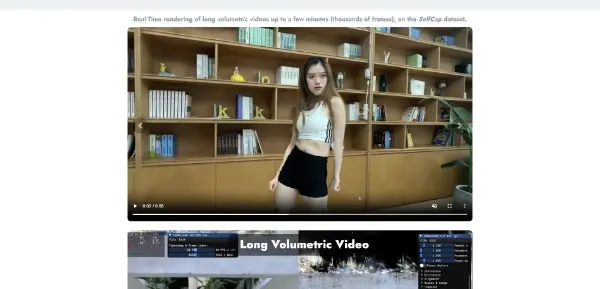Temporal Gaussian Hierarchy

A 3D rendering system that transforms classic videos into volumetric scenes lasting several minutes (4D Gaussians). View content in real time from every angle, in HD quality
Temporal Gaussian Hierarchy: Revolutionizing Video into Interactive 3D
The Temporal Gaussian Hierarchy (TGH) is a groundbreaking open-source 3D rendering system that redefines how we interact with video content. It transforms standard 2D videos into immersive, volumetric scenes, offering unprecedented control and viewing experiences. Instead of a flat, two-dimensional representation, TGH renders videos as 4D Gaussian distributions, allowing for real-time exploration of the scene from any angle in high-definition quality.
What TGH Does
TGH's core function is the conversion of conventional videos into interactive 3D environments. It achieves this by representing the video's temporal and spatial information as a hierarchy of Gaussian functions. This unique approach allows for the reconstruction of the scene in three dimensions, preserving temporal consistency and detail. The result is a volumetric representation of the video that can be explored in real-time, offering a level of immersion not achievable with standard video players.
Main Features and Benefits
- Volumetric Video Representation: Translates 2D video into a full 3D model, allowing for free viewpoint navigation.
- Real-time Rendering: Enables instantaneous viewing from any angle, eliminating the rendering delays common in other 3D video technologies.
- High-Definition Quality: Maintains high-resolution visuals, ensuring a crisp and detailed 3D experience.
- Extended Temporal Coverage: Handles videos lasting several minutes, preserving the temporal integrity of the original content.
- Open-Source Availability: Hosted on GitHub, allowing for community contributions and further development.
- 4D Gaussian Representation: The underlying mathematical model enables efficient storage and manipulation of the volumetric data.
Use Cases and Applications
The implications of TGH are far-reaching, spanning various industries and applications:
- Film and Television: Enhance audience engagement by letting viewers explore scenes from any perspective. Imagine experiencing a film's action sequence from inside the cockpit of a fighter jet or exploring the intricate details of a historical setting.
- Virtual and Augmented Reality (VR/AR): Seamless integration with VR/AR platforms to create immersive and interactive experiences.
- Gaming: Develop new gameplay mechanics centered around navigating and interacting with 3D volumetric video environments.
- Education and Training: Create interactive simulations and training modules offering unique perspectives on complex processes or events.
- Archival and Preservation: Preserve and access historical footage in a more engaging and accessible manner.
- Medical Visualization: Offer surgeons and researchers a way to interact with 3D representations of medical scans and procedures.
Comparison to Similar Tools
While other tools offer some form of 3D video processing, TGH distinguishes itself through its unique approach based on 4D Gaussian distributions, its real-time rendering capabilities, and its extended temporal coverage for multi-minute videos. Many competing technologies struggle with real-time performance for high-resolution, long-duration content. Additionally, TGH’s open-source nature fosters collaboration and community-driven improvements.
Pricing
TGH is currently available for free and open-source via GitHub. This allows for widespread accessibility and encourages community contributions to its ongoing development.
Conclusion
The Temporal Gaussian Hierarchy represents a significant advancement in video processing and 3D rendering. Its ability to transform standard videos into interactive volumetric scenes opens up a new era of immersive video experiences across a broad range of applications. The free and open-source nature of the project ensures its accessibility and fosters innovation within the community. As the technology matures and the community contributes, we can expect even more exciting advancements and applications of this powerful tool.